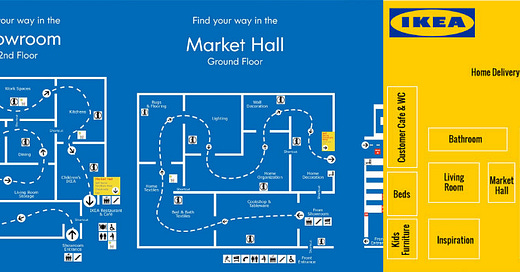Brilliant IKEA strategy every designer should steal
Replicating IKEA’s Secret to Success for Product Designers
Hey there! This is a 🔒 subscriber-only edition of ADPList’s newsletter 🔒 designed to make you a better designer and leader. Members get access to exceptional leaders' proven strategies, tactics, and wisdom. For more: Get free 1:1 advisory | Become an ADPList Ambassador | Become a sponsor | Submit a guest post
Transform your design with AI-powered insights
This newsletter is brought to you by Genway AI—automate the entire user interview process, delivering insights that help you create user-centered designs faster than ever. No scheduling, no staffing—just fast, actionable insights for your next design sprint.
Friends,
This week, we’re dissecting the subtle psychological tricks that make IKEA one of the most effective retail machines in the world—and translating them into actionable insights for digital product designers. From maze-like layouts to decoy pricing and scarcity-driven messaging, IKEA’s store is basically a masterclass in behavioral design.
What if you could replicate that same magic in your app, website, or product flow?
Our guest author breaks down how IKEA’s tactics apply to digital experiences—using examples from Apple, Duolingo, Airbnb, and more—to help you build stickier, smarter, and more profitable products.
Let’s decode the IKEA framework and turn “just browsing” into action. 👇🏻
Dhananjay Garg is a strategic product designer focused on transforming digital experiences at scale. With over 12 years of experience spanning web development, product design, and business strategy, Dhananjay brings a multidisciplinary approach to solving complex user problems. He currently leads UX Web Acquisition initiatives at Delivery Hero (foodpanda), focusing on performance-driven design, web-to-app conversions, and operational tool efficiency. Blending design with business acumen from his ongoing Executive MBA journey, Dhananjay has worked on many 0 to 1 projects like fintech, design systems, employee corporate platforms, and customer growth tools. His work reflects a deep belief in user-first innovation, informed by data, and executed through thoughtful systems thinking.
You can follow Dhananjay on Medium, and LinkedIn.
Replicating IKEA’s Secret to Success for Product Designers
Borrowing ideas from various mind tricks played by IKEA on customers — A design & marketing framework for Product Designers
Drawing from IKEA’s incredibly successful retail strategies, we can craft a powerful design and marketing framework that works not only for physical spaces but also for digital experiences. IKEA’s unique approach to guiding customers through their stores and creating a rich, immersive shopping journey offers valuable lessons for product designers, marketers, and businesses aiming to drive engagement, conversion, and loyalty. Let’s take a look at how IKEA’s tactics translate into digital design, using examples from companies like Apple, Duolingo, and Airbnb that excel at similar strategies.
1. Layout as a behavioral driver
Principle: Design physical and digital spaces to guide customers through adeliberate journey that maximizes exposure to products.
IKEA’s maze-like layout encourages customers to explore the store, creating more opportunities for them to discover and purchase products they weren’t originally seeking. This intentional journey increases the time customers spend in the store, exposing them to different categories and inspiring spontaneous purchases.
Tactic
Maze-like store layout: IKEA structures its store layout like a puzzle, subtly guiding customers to walk through different sections without a direct path to their desired item.
Key application for digital design: Structure websites or apps with strategic upsell or cross-sell opportunities as users navigate toward their primary goal.
Examples
Airbnb creates carefully curated listings that suggest complementary experiences, such as local tours, as users browse accommodations.
Apple’s website often places accessory recommendations at key navigation points, such as suggesting AirPods when users are looking at iPhones. This ensures more exposure to related products that add value to the main purchase.
Business Sense
From a business and profit standpoint, designing layouts that deliberately guide users , like IKEA’s maze-like store flow; is about maximizing product exposure to increase basket size. By structuring the journey so that customers spend more time browsing across categories, businesses boost the chances of impulse buys and cross-sells, leading to higher revenue per visit. In digital products, this means using smart placement of related items, upgrades, or add-ons (like Apple suggesting accessories or Airbnb surfacing local experiences) to nudge users into discovering and buying more than they originally intended, all without disrupting their core goal. This subtle design strategy drives higher conversion rates and greater average order value, directly impacting profitability.
2. Induce scarcity & impulse buying
Principle: Use perceived scarcity and visual cues to trigger fear of missing out (FOMO) and encourage impulsive purchases. IKEA does an amazing job creating urgency by emphasizing limited-time offers and limited availability, which pushes customers to act quickly to secure their desired products.
Tactic
Curated displays: IKEA shows products in beautifully staged mock-ups that make people feel like they are buying into a complete, ready-made lifestyle.
Scarcity messaging: Labels like “Limited Stock” or “Popular Item” are used in-store and online to push customers toward immediate action.
Examples
Duolingo uses streaks and limited-time bonus features to keep users engaged and maintain their commitment to daily practice.
Apple employs scarcity by emphasizing limited product availability during new launches, like a “Pre-Order Now” message that pushes users to be among the first to get a new iPhone.
Business Sense
Inducing scarcity and triggering impulse buying taps directly into urgency driven consumer behavior to boost conversions. By using visual cues like “Limited Stock” or time-bound offers, brands create FOMO (fear of missing out), which pushes customers to act quickly, often without overthinking. This leads to faster purchase decisions and reduced cart abandonment, especially for high-demand or trending items. IKEA’s styled displays and urgency labels, or Apple’s “Pre-Order Now” launches, turn browsing into buying by framing products as exclusive or fleeting opportunities, driving immediate sales and increasing short-term revenue.
3. Price anchoring for value perception
Principle: Present pricing options to make higher-margin items appear as the best value. Price anchoring is when a company shows multiple versions of a product, usually with a middle option that seems like the most reasonable value compared to a basic and a premium version.
Tactic
Decoy pricing: IKEA often presents three versions of a product, such as small, medium, and large, where the medium option seems like the best deal.
Upward comparison: Premium items are displayed next to budget versions to make mid-priced items look more attractive.
Examples
Spotify uses a three-tiered plan to nudge users towards the “Premium” option, which appears to be a better value compared to the free plan and the more expensive family plan.
Apple positions its iPhone models similarly — the “Pro” version offers just enough additional features to make it appear like the best value compared to the standard or “Pro Max” versions.
Business Sense
Price anchoring is a smart way to steer customers toward higher-margin options by shaping their perception of value. By presenting three pricing tiers , often a basic, a mid-tier, and a premium; businesses make the middle option feel like the smartest and safest choice. This tactic, used by IKEA, Spotify, McDonald’s and Apple, subtly nudges users toward spending more than they might have originally intended, without feeling upsold. It boosts average order value and increases profit margins, all while giving customers a sense of control and satisfaction with their purchase.
4. Enhance the experience with complementary offerings
Principle: Use adjacent services or products to keep customers engaged and spending more time. IKEA extends the shopping journey with complementary experiences like food courts, which make people stay longer and enjoy the shopping experience more.
Tactic
Food as an anchor: IKEA’s food courts offer affordable meals to keep customers energized and spending more time in-store.
Complementary shopping: They mix complementary categories — kitchenware next to dining tables — encouraging customers to buy matching items.
Examples
Airbnb offers complementary services like curated travel experiences and local tours when booking accommodations, enhancing the user’s journey.





